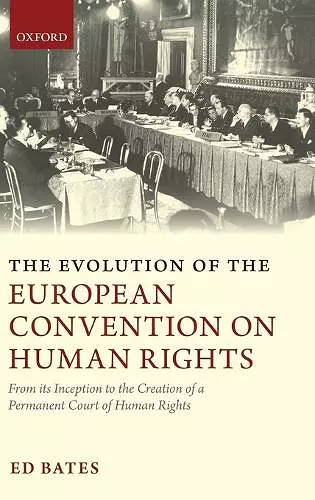The Evolution of the European Convention on Human Rights
From Its Inception to the Creation of a Permanent Court of Human Rights
Format:Hardback
Publisher:Oxford University Press
Published:23rd Dec '10
Currently unavailable, currently targeted to be due back around 20th April 2025, but could change

Shortlisted for The Peter Birks Prizes for Outstanding Legal Scholarship 2011
The European Convention on Human Rights is probably the most effective system of international human rights control created. This book examines the story of the evolution of the Convention over its first 50 years. It explains how the Convention system grew up and how it came to exert such an important influence on the States which subscribe to it.The European Convention on Human Rights underwent a spectacular evolution over the first fifty years of its life. In recent times the European Court of Human Rights has been compared to a quasi-constitutional court for Europe in the field of human rights, and for some time the Convention has been viewed as a European Bill of Rights. The 'coming of age' of the ECHR system in the late 1990s was marked by the entry into force of Protocol 11, creating a new, full time Court. By contrast those who first proposed a European human rights guarantee were driven by an ambition to put in place a collective pact to prevent the re-emergence of totalitarianism in 'free' Europe. They were motivated by grisly memories of human rights abuse associated with World War Two, and the protection of 'human rights' was seen in that light. When the Convention was opened for signature in 1950 it was viewed by many with scepticism and disappointment. The Convention system took many years to get established. In the mid-1960s doubts were expressed as to whether the Court had a future and in the 1970s the Convention system of control faced a number of serious challenges. This book examines the story of the evolution of the Convention over its first 50 years (1948-1998). It reflects on the Convention's origins and charts the slow progress that it made over the 1950s and 1960s, before, in the late 1970s, the European Court of Human Rights delivered a series of landmark judgments which proved to be the foundation stones for the European Bill of Rights that we know today.
Bates has written a lucid, readable book on the development of the European Court of Human Rights, from the kernel of the Convention, written in 1948 as an safeguard against totalitarianism, to its development as a European Bill of Rights, with the court as a constitutional court for Europe delivering landmark jurisprudence at significant points in its development. * David J Dickson, The Journal of the Law Society of Scotland *
Bates picks up the mantle of these earlier important works and his magisterial study is a worthy successor to them. * Urfan Khaliq (Cardiff University), Journal of Law and Society *
This monograph will assist generations of legal practitioners and academics in their quest for arguments supporting particular interpretations of the Convention given that open-ended norms of the Convention provide opportunities for legal creativity and judicial activism. * Kanstantsin Dzehtsiarou, Human Rights Law Review 13:1 *
ISBN: 9780199207992
Dimensions: 241mm x 157mm x 41mm
Weight: 1051g
610 pages